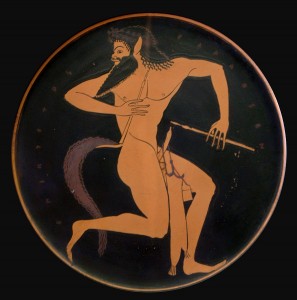Satyr
In Greek mythology, a satyr is one of a troop of male companions of Pan and Dionysus with goat-like (caprine) features, including a goat-tail, goat-like ears, and sometimes a goat-like phallus. In Roman Mythology there is a similar concept with goat-like features, the faun being half-man, half-goat. Greek-speaking Romans often use the Greek term saturos when referring to the Latin faunus, and eventually syncretize the two. The female “Satyresses” were a late invention of poets — that roamed the woods and mountains. In myths they are often associated with pipe-playing.
Satyrs acquired their goat-like aspect through later Roman conflation with Faunus, a carefree Italic nature spirit of similar characteristics and identified with the Greek god Pan. Hence satyrs are most commonly described in Latin literature as having the upper half of a man and the lower half of a goat, with a goat’s tail in place of the Greek tradition of horse-tailed satyrs; therefore, satyrs became nearly identical with fauns. Mature satyrs are often depicted in Roman art with goat’s horns, while juveniles are often shown with bony nubs on their foreheads.
About Satyrs, Praxiteles gives a new interpretation on the subject of free and carefree life. Instead of an elf with pointed ears and repulsive goat hooves, we face a child of nature, pure, but tame and fearless and brutal instincts necessary to enable it to defend itself against threats, and survives even without the help of modern civilization . Above all though, the Satyr with flute has a small companion for him, shows the deep connection with nature, the soft whistle of the wind, the sound of gurgling water of the crystal spring, the birds singing, or perhaps the singing a melody of a human soul that feeds higher feelings.
As Dionysiac creatures they are lovers of wine and women, and they are ready for every physical pleasure. They roam to the music of pipes (auloi), cymbals, castanets, and bagpipes, and they love to dance with the nymphs (with whom they are obsessed, and whom they often pursue), and have a special form of dance called sikinnis. Because of their love of wine, they are often represented holding wine cups, and they appear often in the decorations on wine cups.
